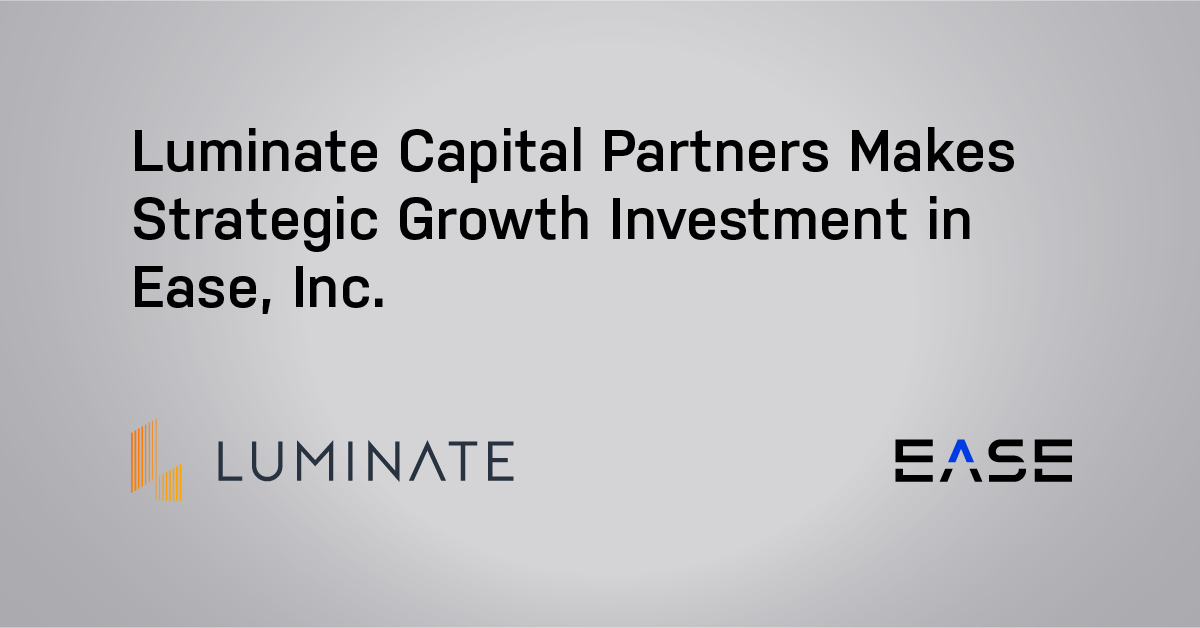SAN CLEMENTE and SAN FRANCISCO – March 14, 2023 – Luminate Capital Partners, a private equity firm focused on enterprise software, announced last week a majority-stake growth investment in Ease, Inc. (“Ease”), a leader in manufacturing plant floor audit software.
Luminate’s investment will help Ease expand its leadership position in the manufacturing software sector by accelerating new product development, innovation, and other key growth initiatives.
The EASE plant floor audit SaaS platform is purpose-built to serve the manufacturing industry. EASE harnesses the plant floor data, provides deep insights into manufacturing processes, and delivers immediate ROI for customers via higher productivity, improved quality and safety, and lower costs and defects. EASE is used in more than 40 countries and 20+ languages to conduct millions of audits every year and is trusted by hundreds of global enterprise customers from automotive to aerospace, electronics, medical devices, food & beverage, packaging and more.
“Manufacturers are just embarking on their digital transformation journey and EASE is right at the center. We are transforming business critical audit processes and providing actionable insights in real time for all types of manufacturing,” said Eric Stoop, CEO of Ease. “Ease is proud to be able to work hand in hand with manufacturers to drive efficiency, increase quality and employee safety, and reduce risk. We are excited to start this next chapter with Luminate and leverage their extensive experience in scaling and driving growth through product expansion and innovation.”
Dave Ulrich, Partner at Luminate, said, “Ease is addressing a large global opportunity. Their innovative platform helps manufacturers simplify how they administer, conduct, and respond to plant floor audits, a process still often done manually on paper. Ease’s platform delivers significant value to customers today and we believe through additional product investment there’s opportunity to offer even more.”
“Ease has seen impressive growth in recent years,” added Chris Murphy, Operating Partner at Luminate. “We are excited to partner with the team to support their continued growth and success.”
In connection with the investment, Hollie Haynes, Chris Murphy, and Dave Ulrich will join Eric Stoop on Ease’s Board of Directors. Spotlight Equity Partners, Ease’s previous majority shareholder, will retain a minority stake.
Suken Shah, Co-Founder and Managing Partner at Spotlight said, “We have been impressed with the entire Luminate team and believe they are a great partner for Ease going forward. We look forward to collaborating with them to build on the company’s strong momentum.”
Lincoln International provided M&A advisory services to the shareholders of Ease and legal advice was provided by McDermott Will & Emery.
Kirkland & Ellis was legal advisor to Luminate.
Terms of the transaction were not disclosed.
About Ease
Ease’s multi-tenant SaaS solution is built for manufacturers of all sizes. The solution automates manual and time-consuming plant floor audits, inspections, and data collection to digitize a historically manual, paper-based approach. Leading manufacturers in 40+ countries around the world, including Dana, Eaton, and 3M, trust Ease to automate plant floor audits and keep pace with manufacturing requirements. Founded in 1986, Ease is headquartered in San Clemente, California. For more information, please visit www.ease.io.
About Luminate Capital
Luminate Capital Partners is a private equity firm investing in growth software companies, based in San Francisco. Luminate’s portfolio of market leaders has included Axonify, Conexiom, Compliance & Risks, StarCompliance, Quantivate, Thought Industries and Suralink. For more information, please visit www.luminatecapital.com.
About Spotlight Equity Partners
Spotlight Equity Partners is a private equity firm investing in enterprise software companies. Spotlight’s current portfolio of software companies includes ScaleGrid, Pharos, Nicus, cFive, SirsiDynix, and Identity Automation. For more information, please visit www.spotlightequity.com.
Media Contact:
For Ease:
Andrea Walter
Chief Marketing Officer
Ease
andrea.walter@ease.io
For Luminate:
Chris Tofalli
Chris Tofalli Public Relations, LLC
chris@tofallipr.com


